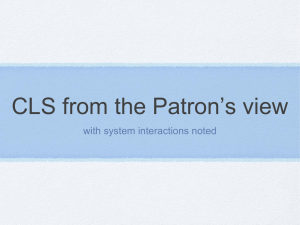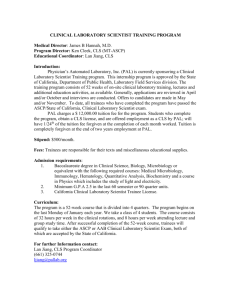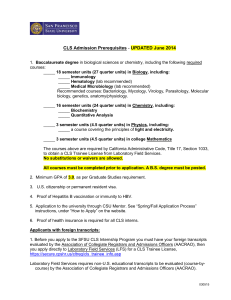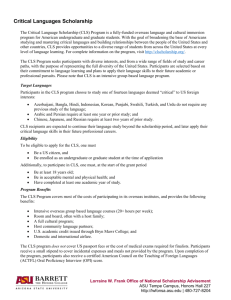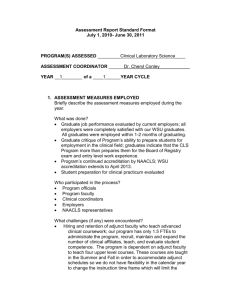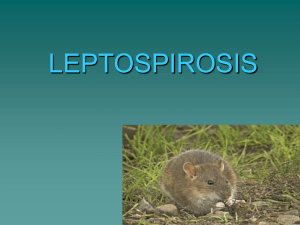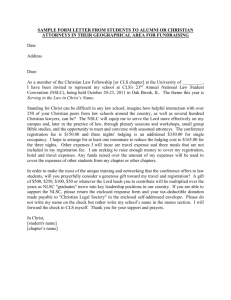max - Figshare
advertisement
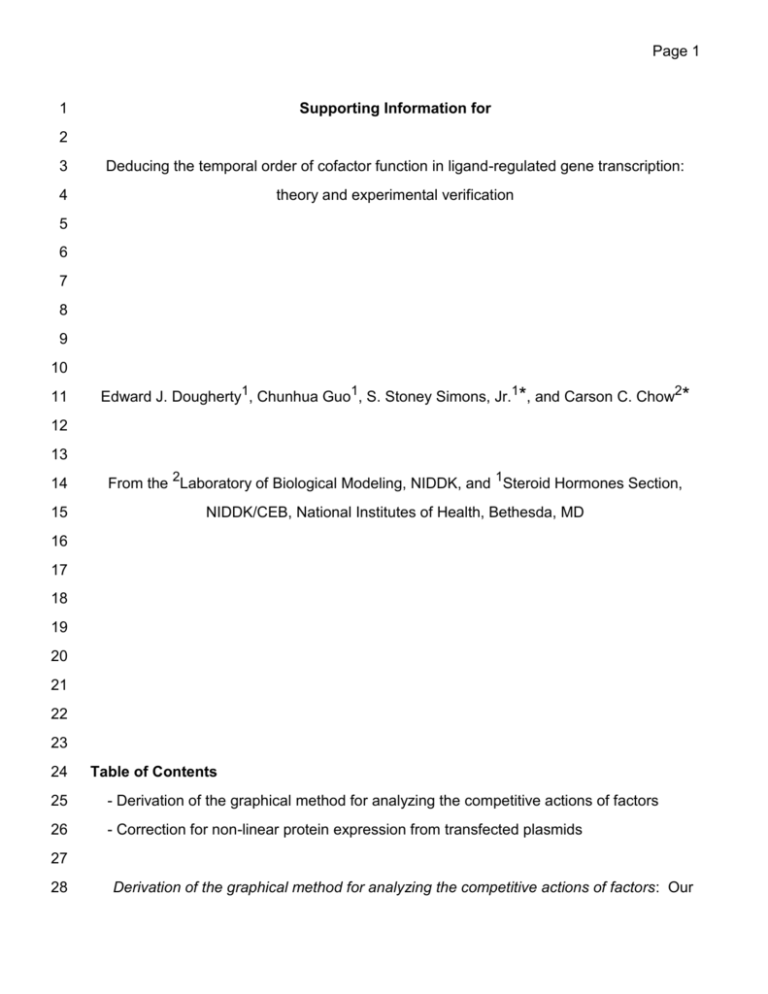
Page 1 1 Supporting Information for 2 3 Deducing the temporal order of cofactor function in ligand-regulated gene transcription: 4 theory and experimental verification 5 6 7 8 9 10 11 Edward J. Dougherty1, Chunhua Guo1, S. Stoney Simons, Jr.1*, and Carson C. Chow2* 12 13 14 From the 2Laboratory of Biological Modeling, NIDDK, and 1Steroid Hormones Section, 15 NIDDK/CEB, National Institutes of Health, Bethesda, MD 16 17 18 19 20 21 22 23 24 Table of Contents 25 - Derivation of the graphical method for analyzing the competitive actions of factors 26 - Correction for non-linear protein expression from transfected plasmids 27 28 Derivation of the graphical method for analyzing the competitive actions of factors: Our Page 2 29 graphical method stems from our theory of steroid-regulated gene induction, which 30 calculates the dose-response curve for a sequence of n reactions [1]. Each reaction step 31 has the form 32 33 34 where Yi is the reaction product of step i, Xi is an activating cofactor or activator, Ii is an 35 inhibiting cofactor or inhibitor. We denote a = 0 competitive inhibition, g = 0 uncompetitive 36 inhibition, a = g noncompetitive inhibition, b = 0 linear inhibition, and b > 0 partial inhibition. 37 Partial inhibition can be activating if it diverts the output to a higher yielding pathway. The 38 dose response curve is obtained by solving the steady state equations for mass 39 conservation and mass action. In general, these equations cannot be solved to obtain a 40 closed form expression for the dose response function of the protein product as a function 41 of the steroid concentration. However, experimentally, it is well established that the dose 42 response curve is closely modeled by a first order Hill function (i.e. Hill coefficient of one). 43 We showed that the dose-response curve for a sequence of n such reactions is a first-order 44 Hill function if reaction products have low concentrations or are short-lived [1]. As shown in 45 Ong et al. (2010), this assumption renders the steady state equations for mass 46 conservation and mass action into a solvable form. 47 48 The first-order Hill constraint also makes the calculation of the dose-response curve 49 tractable and a formula can be written down explicitly in terms of all the parameters of all 50 reaction steps. The constraint also allows intermediate and unknown reaction steps to 51 “telescope” into effective reactions with effective parameters. Hence, for experiments Page 3 52 involving a small number of added cofactors, a model for the dose-response curve can be 53 generated that includes just the action of those cofactors. Within a sequence of reactions, 54 there may be a distinguishing step we termed the Concentration Limiting Step (CLS). The 55 CLS is defined as a step where sets of reactions immediately following it have the property 56 that the amount of cofactor bound to a reaction product is negligible compared to the free 57 concentration. The action of a cofactor is different if it acts before, at or after the CLS and a 58 59 60 61 different parametric model exists for each of these cases. 62 The parametric models have the abstract form GV1cls[S] [P] = 1+ W1cls[S] (S1) 63 where [S] is the steroid concentration, G = å 64 W bm = å wiVbi-1. The parameters i and i, which depend on the parameters of the 65 reactions and differ depending on where they act with respect to the CLS, are given in 66 Table S2, where XT is the total concentration of an added factor and the other 67 parameters come from the reaction given above. The details of the calculation are 68 given in Ong et al. (2010). n k= cls k , Vbm = Õ v i , and ak-clsVcls+1 m i= b m i= b 69 70 71 72 Table S2. Parameter expressions Position Before CLS i < cls At CLS i = cls Activator vi = qi X T i wi = qiei vi same as before CLS Activator with Inhibitor qi X iT (1+ a ib iqi¢[Ii ]) vi = 1+ g iq¢i [Ii ] wi = qi (ei + a iq¢i [Ii ]) 1+ g iq¢i [Ii ] vi same as before CLS k æ n ö qiçå ek Õ v + a clsq¢cls[Icls ]÷ j= i+1 j è k= i ø wi = 1+ g clsq¢cls[Icls ] Page 4 wi = qi å ek Õ n k k= i j= i+1 vj After CLS vi same as before CLS i > cls wi = 0 vi = qi X iT 1+ g iq¢i [Ii ] wi = 0 73 74 75 All combinations of cofactors are accounted for in the general model (S1). To render the 76 general model into a specific parametric form for a given case, we re-express (S1) such 77 that only the concentrations of the desired factors are explicitly visible. All other reactions 78 “telescope” into an effective reaction with a set of effective parameters. For example, if we 79 are interested in an activator acting somewhere before the CLS then we rewrite GV1cls as 80 BX T , where B is a positive parameter that depends on a complicated combination of 81 reaction parameters. The crucial point is that the mechanism of the cofactor can be 82 deduced without knowing the precise value of B. Likewise, we can write W1cls = C + DX T , for 83 positive constants C and D. Hence, the dose-response curve for a single activator acting 84 85 before the CLS has the form 86 [P] = BX T [S] 1+ (C + DX T )[S] 87 88 which implies that Amax = BX T /(C + DX T ), and EC50 =1/(C + DX T ). Hence, for an activator, 89 the graph of Amax/EC50 vs XT is linear with a positive slope and zero y-intercept and the 90 graph of 1/EC50 vs. XT is a linear function with positive slope and nonzero y-intercept. This 91 can then be repeated for all positions and all co-factor types. The computations to isolate 92 93 94 95 cofactors are facilitated with the decomposition rule 96 The identical process can be repeated for two factors. In fact all the conclusions for a single 97 factor can be obtained from the parametric models for two cofactors. Table S3 gives the full W ab = Wac + VacWcb+1 Page 5 98 99 100 101 parametric expressions for two cofactors in all the possible configurations. Table S3. Decomposition rules Position s g<h<cls both before CLS Decompositions B parameters cls V1cls = V1g-1Vgh-1 +1 Vh +1v g v h GV1cls = B2v gv h W1cls = B3 + B4 wg + B5v g g <h =cls before, at CLS V1cls = V1g-1Vgcls-1 +1 v g v cls W1cls = W1g-1 ( ( h-1 cls + V1g-1 wg + v g W gh-1 +1 + Vg +1 ( w h + v hW h +1 ) ( cls-1 W1cls = W1g-1 + V1g-1 wg + v g (Wgcls-1 +1 + Vg +1 w cls ) )) ) + B6v g wh + B7v g v h GV1cls = B2v gv h W1cls = B3 + B4 wg + B5v g + B6v g wcls g <cls< h CLS between V1cls = V1g-1Vgcls+1v g W1cls = W1g-1 + V1g-1( wg + v gWgcls+1) GV1cls = B1v g + B2v g v h W1cls = B3 + B4 wg + B5v g wcls g=cls<h at, after CLS V1cls = V1cls-1v cls W1cls = W1cls-1 + V1cls-1wcls h-1 æ h-1 n k G = å ak-clsVcls+1 + çVcls+1 åk= h ak-clsVhk+1ö÷øvh k= cls è V1cls and W1cls are unaffected g-1 æ g-1 h-1 k G = å ak-clsVcls+1 + çVcls+1 åk= g ak-clsVgk+1ö÷øv g k= cls è æ g-1 h-1 n ö + çVcls+1 Vg +1 å ak-clsVhk+1 ÷v g v h k= h è ø GV1cls = B1v cls + B2v clsv h W1cls = B3 + B4 wcls cls<g<h both after CLS æ h-1 n k ak-clsVcls+1 + çVcls+1 åk= h ak-clsVhk+1ö÷øvh k= cls è G=å h-1 GV1cls = B0 + B1v g + B2v g v h W1cls = B3 + B4 wcls 102 103 Expressions for Amax and EC50 can then be obtained for all cases by inserting the 104 expressions from Table S3 into the general model (equation S1). The results can be 105 106 107 108 summarized in the following five cases: 109 110 1. k < l < CLS Amax = B2v kv l EC50 1 = B3 + B4 wk + B5v k + B6v k wl + B7v kv l EC50 Page 6 111 112 113 114 115 116 117 118 119 Amax ql X lT (1+ a l b l q¢l [Il ]) qk X kT (1+ a kb k q¢k [Ik ]) = B2 EC50 1+ g l q¢l [Il ] 1+ g kq¢k [Ik ] 1 q (e + a k q¢k [Ik ]) æ q (e + a l q¢l [Il ]) q X T (1+ a l b l q¢l [Il ]) ö qk X kT (1+ a kb kq¢k [Ik ]) = B3 + B4 k k + ç B5 + B6 l l + B7 l l ÷ EC50 1+ g k q¢k [Ik ] 1+ g l q¢l [Il ] 1+ g l q¢l [Il ] 1+ g kq¢k [Ik ] è ø 2. k < l = CLS Amax = B2v g v h EC50 1 = B3 + B4 wk + B5v k + B6v k wcls EC50 Amax q X T (1+ a l b l q¢l [Il ]) qk X kT (1+ a kb k q¢k [Ik ]) = B2 l l EC50 1+ g l q¢l [Il ] 1+ g kq¢k [Ik ] 120 ql ( B7 + a l q¢l [Il ]) ö qk X kT (1+ a k bk q¢k [Ik ]) 1 q (e + a k q¢k [Ik ]) æ ÷ = B3 + B4 k k + çç B5 + B6 EC50 1+ g kq¢k [Ik ] 1+ g l q¢l [Il ] ÷ø 1+ g k q¢k [Ik ] è 121 122 123 3. k< CLS < l 124 125 126 127 Amax = B1v k + B2v k v l EC50 1 = B3 + B4 wk + B5v k w cls EC50 Amax æ ql X lT ö qk X kT (1+ a k bkq¢k [Ik ]) = ç B1 + B2 ÷ EC50 è 1+ g l q¢l [Il ] ø 1+ g kq¢k [Ik ] 128 1 qk (e k + a kq¢k [Ik ]) æ ql X lT ö qk X kT (1+ a k bkq¢k [Ik ]) = B3 + B4 + ç B5 + B6 ÷ EC50 1+ g kq¢k [Ik ] 1+ g l q¢l [Il ]ø 1+ g kq¢k [Ik ] è 129 130 131 4. k = CLS < l 132 133 134 135 136 137 138 Amax = B1v k + B2v k v l EC50 1 = B3 + B4 wk EC50 Amax æ ql X lT ö qk X kT (1+ a k bkq¢k [Ik ]) = çB + B ÷ EC50 è 1 2 1+ g l q¢l [Il ] ø 1+ g kq¢k [Ik ] æ ö 1 qk ql X lT = B3 + B4 + a k q¢k [Ik ]÷ ç B5 + B6 EC50 1+ g kq¢k [Ik ] è 1+ g l q¢l [Il ] ø Page 7 139 140 141 142 143 5. CLS < k< l Amax = B0 + B1v k + B2v k v l EC50 1 = B3 + B4 wcls EC50 æ Amax ql X lT ö qk X kT = B0 + ç B1 + B2 ÷ EC50 1+ g l q¢l [Il ] ø 1+ g kq¢k [Ik ] è 144 145 146 1 qk X kT ql X lT = B3 + B4 + B5 EC50 1+ g kq¢k [Ik ] 1+ g l q¢l [Il ] 147 148 149 All of the B parameters are positive numbers. From these five cases we can then extract 150 the graphical behavior of Amax/EC50 vs cofactor and 1/EC50 vs cofactor for all cofactor 151 types, where X iT is the concentration of an activator at step i, [Ii ] is the concentration of the 152 inhibitor at step i, and the type of inhibitor is determined by the parameters a i, bi, and g i. 153 These conclusions are listed in Tables 1 and 2. Note that decreasing curves are always 154 first order decay plots. 155 156 Correction for non-linear protein expression from transfected plasmids: Western blots 157 reveal a non-linear relationship between the optical density of scanned protein band and 158 the amount of transfected plasmid at constant levels either of total cellular protein or of an 159 internal standard, such as b -actin. All of the plots of this study require a linear relationship 160 for the amount of factor given on the x-axis. To determine the linear equivalent of 161 expressed plasmid, the non-linear plot of OD vs. ng of transfected plasmid is first fit to a 162 Michaelis-Menten plot (Fig. S1A) of 163 Amax = m1*plasmid/(m2 + plasmid) 164 The functional equivalent of the transfected plasmid that gives a linear OD vs. plasmid plot 165 is then obtained from the formula of 166 167 Plasmid (linear) = m2*plasmid/(m2 + plasmid) The amount of plasmid plotted in the various graphs is then this “corrected plasmid” value Page 8 168 (Fig. S1B). 169 170 Matching graphs to graphical descriptions: The following algorithms are used to determine 171 which graphical description in Table 1 best describes a given plot. 172 173 1) Examination of the underlying equations (see above) indicates that, for all plots, a negative slope can only be fit to a non-linear MIchaelis-Menten decay curve. 174 2) Whether a plot with a positive slope is linear or non-linear (and curving 175 downward) is based upon the reproducibility of the fit to a straight line, both for all four 176 lines within a given graph and for all such graphs for a given competition experiment. 177 Random fluctuations will occasionally yield data points for one line that may appear to 178 be best described by a downward bending curve. However, if this behavior is not 179 consistently observed, both for the other three plots of the same graph and for the plots 180 of the other experiments under the same conditions, the plot is deemed to be best fit by 181 a straight line. 182 3) In order to decide whether the nonlinear, decreasing curves for Amax/EC50 go to 183 zero (entries 32 or 34 of Table S1) or to a positive plateau value (entries 33 or 35 of 184 Table 1b), one looks at the reciprocal plots (EC50/Amax vs. F1) (2). If the reciprocal plots 185 are straight lines, then the curves of the Amax/EC50 graph go to zero at infinite F1. If the 186 reciprocal plots curve downward, but give linear plots when first subtracting a probable 187 asymptote from the value of Amax/EC50 and then plotting the reciprocal this new value (= 188 1/[(Amax/EC50) – asymptote]), then the Amax/EC50 plot goes to that asymptote at infinite 189 F1 190 4) A final criterion for classifying the nature of a given plot comes from the analysis 191 of the graphical interpretations of the 4-6 plots utilized for a given competition 192 experiment. The final interpretation must be consistent with the partial interpretation 193 derived from each type of graph. No one graph can uniquely define all of the 194 relationships of the two factors and their kinetic mechanism. Rather the assembly of 195 graphs, and their partial interpretations, are used to construct the final mechanism. In Page 9 196 this respect, the final mechanism is that area of common overlap of the possible 197 scenarios of each type of graph. This is pictorially represented in Fig. S4. Each circle 198 represents one type of graph, with sectors of each circle representing the different 199 possible mechanisms associated with the graph. By identifying that scenario of each 200 graph that is consistent with all of the other graphs (indicated by the filled area where all 201 six circles overlap), one usually arrives at a unique mechanistic explanation. If two 202 descriptions of one graph appear to be equally possible but only one gives “overlap” 203 with the other 3-5 plots, then this “overlapping” plot is selected. 204 205 References 206 1. Ong KM, Blackford Jr JA, Kagan BL, Simons Jr SS, Chow CC (2010) A new 207 theoretical framework for gene induction and experimental comparisons. Proc Natl 208 Acad Sci U S A 107: 7107-7112. 209 210 211 212 213 214 2. Chow CC, Ong KM, Dougherty EJ, Simons, Jr. SS (2011) Inferring mechanisms from dose-response curves. Methods in Enzymology 487: 465-483.

